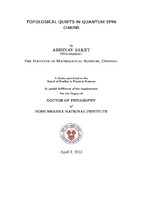- DSpace Home
- →
- IMSc Theses/ Dissertations
- →
- IMSc Theses/ Dissertations
- →
- View Item
JavaScript is disabled for your browser. Some features of this site may not work without it.
| dc.contributor.author | Abhinav Saket | |
| dc.date.accessioned | 2013-04-29T11:15:56Z | |
| dc.date.available | 2013-04-29T11:15:56Z | |
| dc.date.issued | 2013 | |
| dc.date.submitted | 2013 | |
| dc.identifier.uri | https://dspace.imsc.res.in/xmlui/handle/123456789/336 | |
| dc.description.abstract | This thesis investigates one dimensional generalisations of the Kitaev model and study robustness of topological qubits in one dimensional quantum spin chains. The Kitaev model, a two dimensional model on honeycomb lattice, was proposed by A.Yu. Kitaev for possible implementation of topological quantum computation. This model has anisotropic type nearest neighbour spin-spin interaction which depends on the direction of the bonds. The x, y, and z links in the Hamiltonian are three different bonds in the hexagonal lattice, which are related by 120 degree rotation. This model has conserved quantities associated with each hexagonal plaquette and all closed loops. The spin model has been fermionised by Jordan-Wigner transformation. This fermionisation process maps the original spin 1/2 Hamiltonian into a tight binding Hamiltonian of Majorana fermion where hopping amplitude contains the local static Z2 gauge fields. It has been shown that ground state sector belongs to the case where all Z2 gauge fields take value +1. The translational invariance of Z2 gauge fields in the hopping amplitude has allowed to calculate the ground state energy and a set of low lying excited states exactly. For this particular gauge configuration the spectrum has two distinct phases. For certain values of parameter the spectrum is gapless otherwise it is gapped. While the gapped phase contains abelian anyonic excitations, the gapless phase contains non-abelian excitations. In presence of magnetic field the gapless phase acquires a gap. The fact that Kitaev model has non-abelian excitations which can be used for quantum computation attracted the author's attention. Kitaev's honeycomb model can be generalised to a variety of other lattices [2,3,4,5,6]. All generalised Kitaev models are integrable , in the sense that all of them reduce to systems of non-interacting Majorana fermions. They can be constructed on any lattice with coordination number three, if all the bonds can be coloured using three colours. The author considers - two generalised models, the Tetrahedron model and the XYZ-Ising model, in this study. | en_US |
| dc.publisher.publisher | The Institute of Mathematical Sciences | |
| dc.subject | Topological Qubits | en_US |
| dc.subject | Quantum Computation | en_US |
| dc.title | Topological Qubits in Quantum spin chains [HBNI Th51] | en_US |
| dc.type.degree | Ph.D | en_US |
| dc.type.institution | HBNI | en_US |
| dc.description.advisor | Shankar, R. | |
| dc.description.pages | 127p. | en_US |
| dc.type.mainsub | Physics | en_US |
| dc.type.hbnibos | Physical Sciences |
Files in this item
This item appears in the following Collection(s)
-
IMSc Theses/ Dissertations
IMSc Theses/ Dissertations
